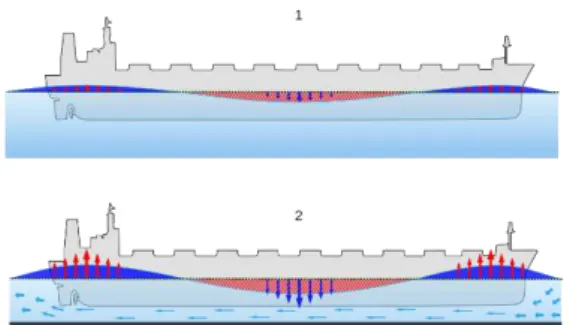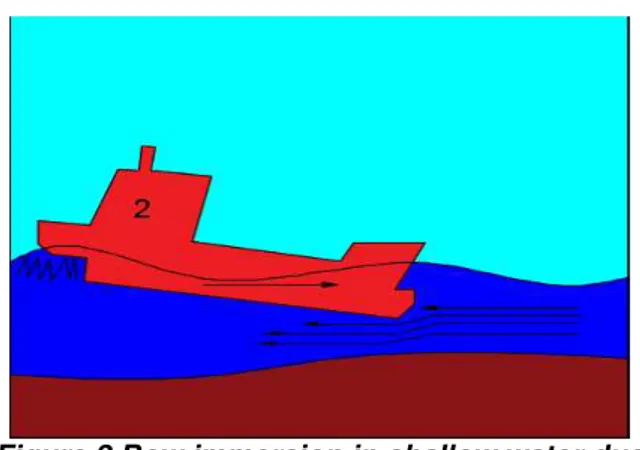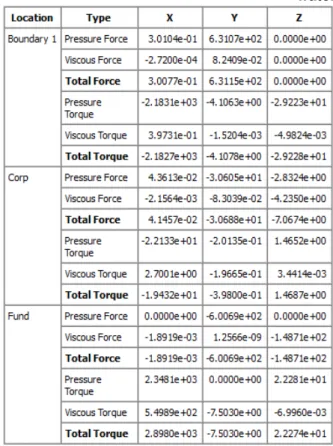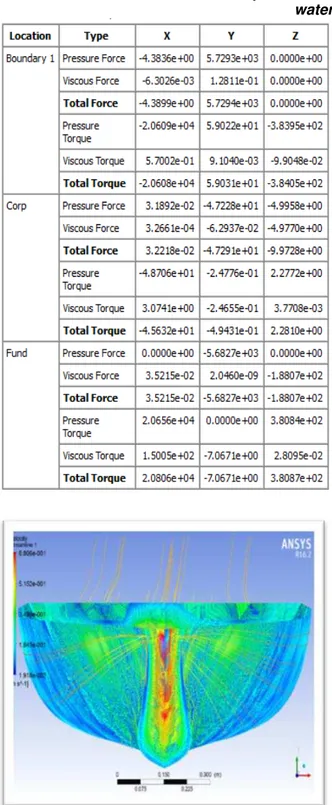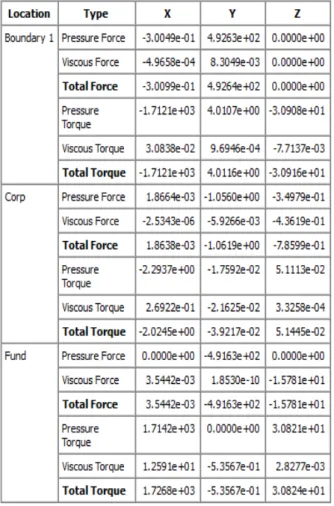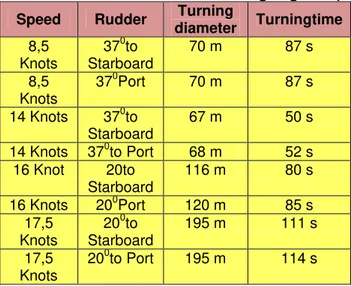THE INFLUENCE OF SQUAT ON THE
MANEUVERABILITYOF”MUSCA”CLASSMINESWEEPER
Ionut Georgian ZAMAN1 Alecu TOMA2
Lavinia Georgiana PASCU3
1
Eng., Navy Application School, Mangalia, Romania, Ionut_georgian92@yahoo.ro
2
Eng., PhD, „Mircea cel Batran” Naval Academy, Constanta, Romania, alecu.toma@anmb.ro
3
Eng., Navy Application School, Mangalia, România, laviniageorgiana.pascu@yahoo.com
Abstract: The squat effect, defined as the reducing the distances between keel and sea bed because of hydrodynamic phenomenon, appears when a vessel is moving through shallow water. Small under keel clearances can cause important sinking and higher risks of bottom collision. In this paper we developed a computer software package for squat calculation using "Visual Studio Express Edition" that offers a quick calculation, efficiently and accurately. We study regarding forces acting on the body of the " MUSCA" Class Minesweeper when squat effectoccurs. We made two simulations that show the forces acting over the body of the ship and how it reacts in shallow water. We considered two working speeds, the march speed of the ship and the sweeping speed. We analyze the squat influence on the evolutionary qualities of the”MUSCA” Class Minesweeper.
Keywords: Squat, under keel clearance, shallow water, minesweeper.
Introduction
The ships’ maneuvering is not simple; it is much diversified, because the ship changes its hydrodynamic behavior depending on the area where it sails. The ship can sail in deep water (seas and oceans) or shallow water and tight areas (rivers, canals and estuary).
The ships’ behavior is modified especially in shallow water areas, because the underkeel clearance decreases. The underkeel clearance is an important element, even vital, when navigating in shallow waters. It is an important factor in designing and maintaining the navigable ways, but it also ensures the safety of navigation.
Water depth affects directly the speed of the ships as well as their efficiency in different areas where they navigate. When the depth is lower than double of the draft, it is considered that the ship is in a shallow water area.
Figure 1.Forces acting on the body of the ship indeep and shallow water
(https://en.wikipedia.org/wiki/Squat_effect)
As well as the under keel clearance is lower, the higher the hydrodynamic effect between the keel and the bottom of the water, leading to the „shallow water effect”. Normally, there should not be a big draft difference between stationary and moving forward status. If the ship moves forward, at a high speed, in shallow water, draft can be from 1 to 1.5 meters and the ship can hit the seabed with bow or stern [2]. When the waves at the bow and stern increase their height, the speed must be reduced gradually, not suddenly. When we reduce the speed suddenly, the formation and the movement speed of the groups of waves decreases [3].
1. Calculation of squat 2.1 Squat effect theory
Squat phenomenon occurs in shallow water when a ship is under way or the ship is not under way but it is influenced by currents. This effect is the difference between the shown value of the draft and the draft of the ship under way or under the effect of the currents. It is defined as the change of the vertical position of the ship and is normally characterized by the dynamic change of trim. Bow and stern immerse as the speed increases, but with different values.
For the military ships, the effect is strong, considering their high speeds. It is very important that the squat should be held under control, avoiding areas where the ship can be put ashore, leading to the failure of the mission.
128 DOI: 10.21279/1454-864X-16-I2-019
The draft of the military ships and the depth of the waters nearby the shore and the ports, along the Danube River and the Danube-Black Sea canal, make this a mandatory element in planning trips and military missions in maximum safety condition. Squat effect always occur, even on small ships which did not have great speeds, but being at a scale of centimeters, this was not a main issue. But, for a military ship, which advances rapidly through shallow water, we can have a bow immersion up to 0.5 meters according to figure 2. The advance resistance lowers, leading to a less effective military mission, and also the risk that the ship touches the bottom of the water.This fact can cause a water hole, moment when the damaged ship cannot operate[1].
Figure 2.Bow immersion in shallow water due to squat
2.2. Squat effect- calculation methods
The squat effect begins to manifest when the depth of the water is 1.5 times lower than the draft of the ship and it is pretty hard to determine precisely the value of this immersion. That is why to calculate the squat effect; we can use one of three methods. These methods don’t offer a precise result but an approximate value.
a. The first method of calculation uses ships’ draft as the main variable and the formula is the following:
SQUAT =10% from the ships’ draft;
b. The second method of calculation uses the ships’ speed as the main variable and the calculation formula is the following:
SQUAT =0.3 meters for each multiple of 5 Knots in the ships’ speed;
c. The third method of calculation is the most used one, because the resulting values are not approximate, but accurate and used as variables, the speed of the ship and the block coefficient of the hull. The formula is the following:
SQUAT = [meters];
To reach the final result, we respect the following calculation algorithm:
• It is calculated the block coefficient of the hull:
Cb= [ ]
• It is calculated the blocking factor S (it was experimentally determined that the advance resistance is maximum when the ratio between the area of the immersed section of the maximum width and the area of the transversal cross section of the canal is between 0,007-0,01):
S =
• It is calculated maximum squatfor canals, closed waters and rivers:
Squatmax = [m]
If the ship is in open water with shallow depths, B(canal width) is determined by the formula:
B = {7.7 + 20 * ( 1 – Cb)*2} * b
We can also use two short formulas for maximum squat, but with the following conditions:
a) Squatmax = [m], for open waters,
only if is between 1.1 and 1.4 meters.
b) Squatmax = [m], for canals,
rivers, only if S, the blocking factor, is between 0.1 and 0.265 meters [4].
2.3Squat effect calculation software
To calculate more quickly the squat effect and to shorten reaction time if we are sailing in waters very shallow, so the ship will not be put ashore, a program was conducted to calculate the effect. To develop the program, we used the package "Visual Studio Express Edition" that offers a quick calculation, efficiently and accurately.
We implemented seven textbox sites as shown in figure 3 for the introduction of known data about the ship and the navigable canal / river. These textbox sites also serve to filter the input. We should consider that the user of the program can enter invalid characters as "a", "b", "%" etc., which may result in compilation errors and even blocking the software.
129 DOI: 10.21279/1454-864X-16-I2-019
Figure 3.Squat calculation software
Data inserted in the software are known by the officer utilizing it, such as water depth, canal width, speed, as well as technical and tactical characteristics of the ship.
After pressing the computing button "Start", the results are displayed in the textbox’s "Hull Block Coefficient", "Cross Sectional Area" and "Maximum Squat". In the textbox values cannot be edited manually, you cannot enter data other than those calculated by the program to avoid possible falsification of the results. If the maximum squat is greater than 1.5 * draft, the ship program displays an alert. The message alerts that the depth below keel is not safe, with the possibility of putting the ship ashore, and it can cause water hole [5].
2. Study regarding forces acting on the body of the ”MUSCA Class”Minesweeper when squat effect occurs.
For a more precise study of the squat effect on the MUSCA Class Minesweeper, we did simulations which show the forces which act over the body of the ship and how it reacts in shallow water. We considered two working speeds, the march speed of the ship which is 12Knotsand the sweeping speed which is 3 Knots. It was established different speeds for the model, deep and shallow water values. The calculation speeds are:
Corresponding to 12 Knots, results a model speed of 1.13 Knot- 0.581 m/s;
Corresponding to 3 Knotsresults a model speed of 0.283 Knots- 0.145 m/s.
Figure 4.MUSCA Class minesweeper Model ship at scale 1:10.6
Since the length of the ship is 60.8 meters, the model ship is 5.85 meters, as shown in figure 4. Approximate Scale is 1:10.6, and hence the similarity theory will use two scales, considering the coefficient of unitary symmetry [6].
Simulation 1
For 12 Knotsspeed, which resulted in 1.13 Knotsin simulation for model, the forces that act are more obvious in shallow water, where the squat effect occurs, represented by the color blue, being more obvious in shallow water accord to figure 5.
Table 1.Forces and torsion torque in deep water
130 DOI: 10.21279/1454-864X-16-I2-019
Table2.Forces and torsion torque shallow water
Figure 5.Squat effect in shallow water – speed 1.13 knots
Simulation 2
It is used the sweeping speed of the ship, which is 3 Knots, and result a 0.283 knotsfor model ship according to table 3. The water volume displaced as waves reaches the shore and then returns to the ship. We can see how these waves in shallow
water create a higher pressure, unlike deep water, fact which leads to the apparition of the squat effect. This fact is noticed by the intensification of the color red in the stern area, according to figure 6.
Table 3.Forces and torsion torque in deep water
Figure 6.Squat effect in shallow water – speed of 0.283 Knots
131 DOI: 10.21279/1454-864X-16-I2-019
Table 4. Forces and torsion torque in shallow water
3. Squat influence on the
evolutionaryqualities of the ”MUSCA Class” Minesweeper
Evolutionary qualities on a ship are those qualities which allow it to move through water and maneuver in the desired direction.
4.1 Squat influence on the speed
Squat effect is directly proportional to the speed of the vessel and thus leads to a partial loss of speed, reducing it up to 20-30%. Considering the march speeds of maritime mine dredger, the minimum speed (lowest speed at which the vessel can govern), economic speed (minimum fuel consumption), full speed (engine nominal parameters), maximum speed (machine at full power).We determined the parameters when squat occurs at certain speeds, the results are found in table 5 [8].
Table 5.Speed regimes of the Minesweeper when squat occurs(wind speed 3 m/s, sea state 3, working engines2) Minesweeper speed in
deep water
Minesweeper speed in shallow water
8.5 knots 2.2 knots
14 knots 3.5 knots
16 knots 4 knots
17.5 knots 4.4 knots
4.2 Squat influence on the turning circle
The turning of the ships is the return movement of the ship by a curve trajectory and represents the ability of the ship to change movement direction under the combined effect of the rudder and the propeller. Theoretical, only the trajectory of the gravity center of the ship is studied.
The turning radius is described by the gravity center of the ship and it look like a logarithm spiral almost like a circle. When the ship’s movement becomes steady the turning radius becomes a circle.
To be able to study the influence of this effect over the turning radius of the Maritime Sweeper, it was used table 6 with the turning radius values at maximum speed
Considering that the maximum speed of the MUSCA Class Minesweeper is 17.5 Knots, we have a turning radius (D0) of 195 meters.
When squat effect occurs, it is approximated that the ships’ speed is reduced by 30% accordinglywith squat theory and the speed becomes 5.25Knots in shallow waters. To be able to represent the turning radius of the minesweeper in shallow/deep waters we performed the following calculations:
In high depth areas: a) Tactical radius
Dt = (0.9 – 1.2) * D0 = 58.5 meters; b) Advance (forward):
l1 = (0.6 – 1.2) * D0 = 117 meters; c) Transfer (direct movement):
l2 = (0.5 – 0.6) * D0 = 19.5 meters; d) Drift (inverse movement):
l3 = (0.0 – 0.1) * D0 = 19.5 meters.
In areas with shallow water (where the squat effect occurs), the turn radius increases because the speed and steering angle decrease, and the ship handling becomes increasingly difficult. The difference between the two curves is represented in figure 7.
132 DOI: 10.21279/1454-864X-16-I2-019
Figure 7. Turning circle in shallow and deep water
Practically, the turning elements of the ship are measured from 5 to 5 Knots, starting from minimum to maximum speed and for rudder angles form 5 to 5 points to the maximum rudder.
Table 6.The values of the turning diameter(wind speed 3 m/s, sea state 3, working engines2)
Speed Rudder Turning
diameter Turningtime 8,5
Knots
370to Starboard
70 m 87 s
8,5 Knots
370Port 70 m 87 s
14 Knots 370to Starboard
67 m 50 s
14 Knots 370to Port 68 m 52 s 16 Knot 20to
Starboard
116 m 80 s
16 Knots 200Port 120 m 85 s 17,5
Knots
200to Starboard
195 m 111 s
17,5 Knots
200to Port 195 m 114 s
At military ships, the turning elements must be established for all engine rotation steps.For the minesweeper which is a two propeller engine, there is the possibility to work with two engines or only one. Turningdiameter presented above are represented when the ship uses both engines [7]. 4.3 Squat influence on the ship inertia
Inertia is the quality of ship to cover a certain distance to march forward or astern after the main engine was stopped, until it stops moving.
The inertia of the ship is influenced by the size of its construction, charging status, draft and trim, the engine rotations, cleanness of the immersed surface, the degree of the agitation of the water, wind power, water depth under the keel and the direction in which the hydro-meteorological factors
act on the vessel in relation to the direction of the ship.
Table 7. The values of the inertia (wind speed 3 m/s, sea state 1, working engines 2) Ship
Speed Distance Observations
8,5 knots
407 m AHEAD-STOP 91 m STOP - ASTERN 213 m ASTERN - STOP
73 m ASTERN – STOP - AHEAD
14 knots 486 m AHEAD - STOP
16 knots 520 m AHEAD - STOP
17,5
knots 578 m AHEAD - STOP
Items that characterize ship inertia are the time necessary to stop the ship and the space traveled by the ship until its stop. When referring to the inertia of the ship as one of its specific elements of maneuver we must remember that each ship have the following inertia, which must be taken into consideration:
a) the inertia of the ship under way; b) inertia at the helm;
c) ship turning inertia; d) ship inertia coefficient.
Considering that the keel clearance influences ship inertia, we demonstrated that the ship inertia of the minesweeper has a lower value in shallow waters, especially when the squat effect occurs. This takes place because the environment has an increased resistance to the advancement of the ship. To represent this, we used table 7 of inertia values of the minesweeper.
We represented the inertia of the minesweeper for the maximum speed when squat occurs. The maximum speed of the vessel in shallow waters decreases to approximately 5.25 knots. Waves reaching the shore, and then reflected by the vessel, represent an additional resistance to the advance of the ship, which means that the ship significantly reduces inertia [9].
4.4 Squat influence over the ship stability
The ship stability is anevolutionary quality of the ship to maintain a certain direction as long as possible when the rudder is amidships. The ship stability and turning are two main evolutionary dynamic and contradictory qualities of the ship. By combining these two qualities it is obtained another capital quality of the ship named governance.
The ship that has good road stability turns harder and the ship that turns easily has lower stability, the ships’ safety cannot be ensured without the
133 DOI: 10.21279/1454-864X-16-I2-019
two dynamic qualities which are maneuverability and turning.
Squat effect influences ship’s turning, inertia and speed, more exactly maneuverability, as well as its steadiness. From squat theory it is known that
at low depth, under the keel, there are some eddy currents which act over the rudder and also over its steadiness [10].
CONCLUSIONS
The paper presents the influence of the squat effect on the minesweeper maneuverability. To ensure the lowest risk level for the ship, the squat must be treated very seriously.
The data from the simulations show that the ship reacts very quickly when squat occurs, therefore this must be prevented and avoided. To know the value with the ship is immersed in low depth areas, we can use the squat calculation program, which offers precise values in a short time.
The MUSCA Class Minesweeper is a medium size ship, and squat can have significant results. It is very important for the officer on the watch to know very well to use all the equipment on board andthe ship technical and tactical characteristicsto be able to react quickly and correctly, in a short time,and to avoid or fix the problems when theyoccur.
BIBLIOGRAPHY
[1] Constantin Maraloi, ,, Manevra navei în condiții speciale “, Editura ExPonto, 2003.
[2] Deboveanu M., ,,Tratat de Manevra Navei “ – volumul 1, Editura Lumina Lex, București, 1999. [3] Deboveanu M., ,,Tratat de Manevra Navei “ – volumul 2, Editura Lumina Lex, București, 1999.
[4] Cpt. Rg. 1 Petre I. Zamfir, Cpt. Rg. 1 Bartalos Bela, ,, Manevra navei cu propulsive mecanică“, Editura
Institutul de Marină ,, Mircea cel Bătrân “, Constanța, 1979.
[5] Dr. C.B. Barrass, ,,Ship Squat and Interraction “, Publishing Group Witherby, 2009.
[6] Georgeta Praisler, ,,Similitudinea Sistemelor Elastice ’’, Editura Academiei Republicii Socialiste România, 1974.
[7]K.S. Varyani, ,, Squat effects on high speed craft in restricted waterways ’’, Ocean Engineering 33 (2006) 365–381.
[8]Michael J. Briggs, ,,Prediction of Squat for Underkeel Clearance ’’, USA, 2003. [9] http//: http://www.academia.edu
[10] http//: http://www.ship-squat.com
134 DOI: 10.21279/1454-864X-16-I2-019
